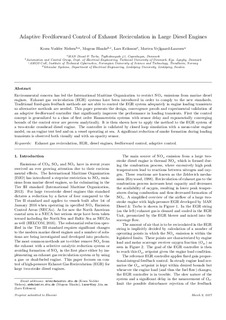| dc.contributor.author | Nielsen, Kræn Vodder | |
| dc.contributor.author | Blanke, Mogens | |
| dc.contributor.author | Eriksson, Lars | |
| dc.contributor.author | Vejlgaard-Laursen, Morten | |
| dc.date.accessioned | 2017-06-07T07:23:02Z | |
| dc.date.available | 2017-06-07T07:23:02Z | |
| dc.date.created | 2017-06-06T14:49:53Z | |
| dc.date.issued | 2017 | |
| dc.identifier.citation | Control Engineering Practice. 2017, 65 26-35. | nb_NO |
| dc.identifier.issn | 0967-0661 | |
| dc.identifier.uri | http://hdl.handle.net/11250/2444499 | |
| dc.description.abstract | Environmental concern has led the International Maritime Organization to restrict NO$_x$ emissions from marine diesel engines. Exhaust gas recirculation (EGR) systems have been introduced in order to comply to the new standards. Traditional fixed-gain feedback methods are not able to control the EGR system adequately in engine loading transients so alternative methods are needed. This paper presents the design, convergence proofs and experimental validation of an adaptive feedforward controller that significantly improves the performance in loading transients. First the control concept is generalized to a class of first order Hammerstein systems with sensor delay and exponentially converging bounds of the control error are proven analytically. It is then shown how to apply the method to the EGR system of a two-stroke crosshead diesel engine. The controller is validated by closed loop simulation with a mean-value engine model, on an engine test bed and on a vessel operating at sea. A significant reduction of smoke formation during loading transients is observed both visually and with an opacity sensor. | nb_NO |
| dc.language.iso | eng | nb_NO |
| dc.publisher | Elsevier | nb_NO |
| dc.rights | Attribution-NonCommercial-NoDerivatives 4.0 Internasjonal | * |
| dc.rights.uri | http://creativecommons.org/licenses/by-nc-nd/4.0/deed.no | * |
| dc.title | Adaptive Feedforward Control of Exhaust Recirculation in Large Diesel Engines | nb_NO |
| dc.type | Journal article | nb_NO |
| dc.type | Peer reviewed | nb_NO |
| dc.description.version | acceptedVersion | |
| dc.description.version | publishedVersion | |
| dc.source.pagenumber | 26-35 | nb_NO |
| dc.source.volume | 65 | nb_NO |
| dc.source.journal | Control Engineering Practice | nb_NO |
| dc.identifier.doi | 10.1016/j.conengprac.2017.05.003 | |
| dc.identifier.cristin | 1474311 | |
| dc.relation.project | Norges forskningsråd: 223254 | nb_NO |
| dc.description.localcode | ©2017 Elsevier Ltd. All rights reserved. This is the authors' accepted and refereed manuscript to the article. Locked until 31 August 2019 due to copyright restrictions | nb_NO |
| cristin.unitcode | 194,63,25,0 | |
| cristin.unitname | Institutt for teknisk kybernetikk | |
| cristin.ispublished | true | |
| cristin.fulltext | postprint | |
| cristin.fulltext | original | |
| cristin.qualitycode | 1 | |

